1. Introduction: What is Biogeography?
Charles Darwin’s Origin of Species (1859) opens with these words:
When on board H.M.S. Beagle as naturalist, I was much struck with certain facts in the distribution of the inhabitants of South America, and in the geological relations of the present to the past inhabitants of that continent. These facts seemed to me to throw some light on the origin of species…
Today, we refer to the study of the geographic distribution of species as biogeography. Both Darwin and Alfred Russell Wallace (the co-discoverer of the idea of natural selection) made important early contributions to this field.
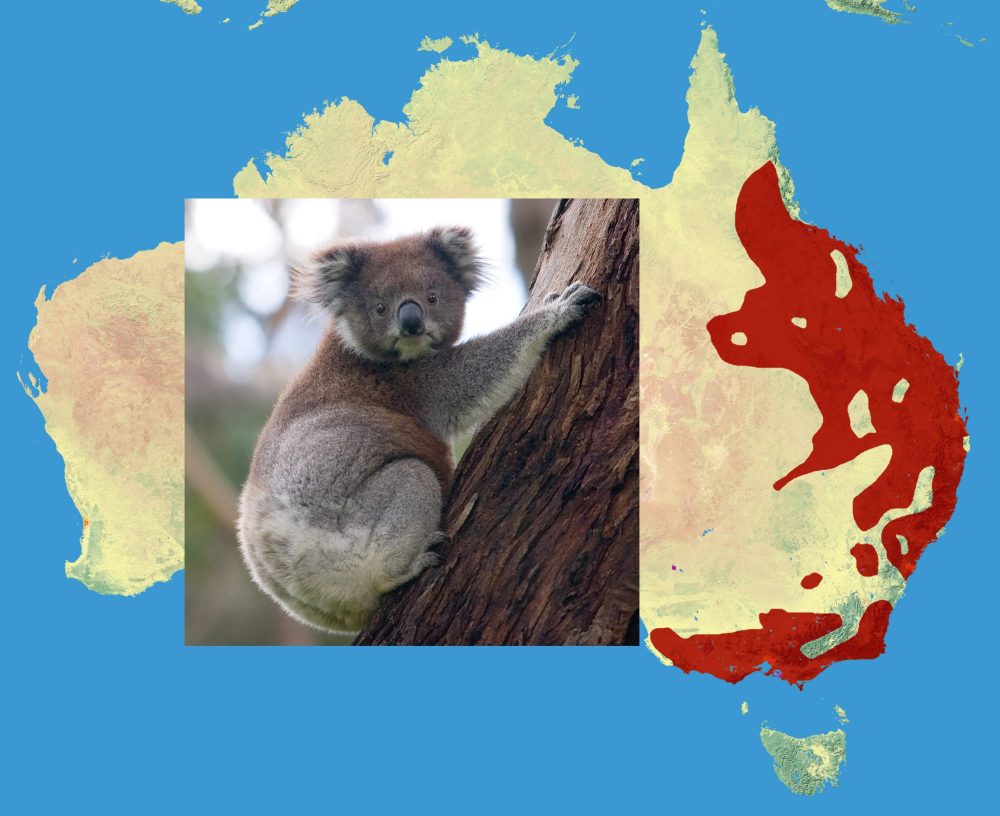
Here’s an example of a biogeography-related question. Half of the mammals in Australia are marsupials: pouched mammals such as kangaroos, koalas, and wombats. By contrast, North America has only one marsupial species: the Virginia opossum. The rest of North America’s mammals are placental mammals. Why do so many marsupials live only in and around Australia, and nowhere else?
Biogeography reflects the history of how species have spread out over the Earth’s surface. Not surprisingly, biogeography also provides evidence for evolution.
2. Biogeography and Convergent Evolution Case Study # 1
Take a look at the following plants.
[qwiz summary=”true” repeat_incorrect=”true” qrecord_id=”sciencemusicvideosMeister1961-Mystery Succulent (v2.0)”]
[h] Mystery Succulent
[q] Plant 1
[q] Plant 2
[q] Plant 3
[q] If you (like most people in North America) had to guess what type of plants were shown in the previous slides (one of which is shown below), what would you guess? Most people guess a six-lettered plant family: [hangman]
[c]IENhY3R1cw==[Qq]
[f]IFJpZ2h0JiM4MjMwO1RoYXQmIzgyMTc7cyBpbmRlZWQgd2hhdCBtb3N0IHBlb3BsZSB3b3VsZCBndWVzcywgYnV0IHRoYXQmIzgyMTc7cyBub3QgY29ycmVjdC4gVGhlc2UgcGxhbnRzIGFyZSBhbGwgZXVwaG9yYnM=LiBFdXBob3JicyBhcmUgc3VwZXJmaWNpYWxseSBsaWtlIGNhY3RpLCBidXQg[Qq]not closely related to them. Euphorbs live in the deserts of Africa, Asia, and the driest parts of Europe. Cacti, by contrast, are mostly limited to North and South America.
[q]Study the pictures below of a cactus (left) and a euphorb) right
| Barrel Cactus, Arizona, USA | Euphorbia grandialata, Canary Islands, Spain |
Continue to the next card to see how this relates to evolution.
[q labels=”top”]Cacti and euphorbs are both ___________ to living in deserts. To avoid __________ loss, their ___________ have become reduced to spines. Their ________ are thick, coated with wax, and adapted for water_________.
[l]leaves
[fx] No. Please try again.
[f*] Excellent!
[l]adapted
[fx] No. Please try again.
[f*] Good!
[l]stems
[fx] No, that’s not correct. Please try again.
[f*] Good!
[l]storage
[fx] No, that’s not correct. Please try again.
[f*] Great!
[l]water
[fx] No, that’s not correct. Please try again.
[f*] Good!
[q labels=”top”]But cacti and euphorbs evolved these adaptations separately. In other words, as plant species go, they’re not closely ____________ to one another. They did not inherit their adaptations from a common _______________.
[l]ancestor
[fx] No, that’s not correct. Please try again.
[f*] Correct!
[l]related
[fx] No. Please try again.
[f*] Good!
[q labels = “top”]To converge, means to come together, as in “lines converging.” __________________ evolution is the process by which similar selective pressures act upon _____________ related lineages, resulting in _______________ similar _______________ in the descendants.
[l]adaptations
[fx] No. Please try again.
[f*] Excellent!
[l]Convergent
[fx] No. Please try again.
[f*] Good!
[l]distantly
[fx] No. Please try again.
[f*] Good!
[l]superficially
[fx] No. Please try again.
[f*] Excellent!
[x]Read on to see how convergent evolution supports evolutionary theory.
[/qwiz]
Why do distant areas with similar climates support unrelated species that, like cacti and euphorbs, have similar adaptations? Because of descent with modification. Over the course of evolution, one lineage of plants became adapted to the deserts of North and South America. This lineage gave rise to the cacti. Another lineage became adapted to the deserts of Eurasia, Africa, and Australia. This lineage gave rise to the euphorbs. If you look superficially, they’re similar. But a deeper look (one that includes, for example, looking at their DNA), reveals that these species aren’t closely related.
You can think of convergent evolution as being the counterpart of adaptive radiation. In adaptive radiation, one ancestral species diverges into several descendant species, each with distinct adaptations. In convergent evolution, unrelated lineages converge into superficially similar forms.
3. Biogeography and Convergent Evolution: Case Study # 2
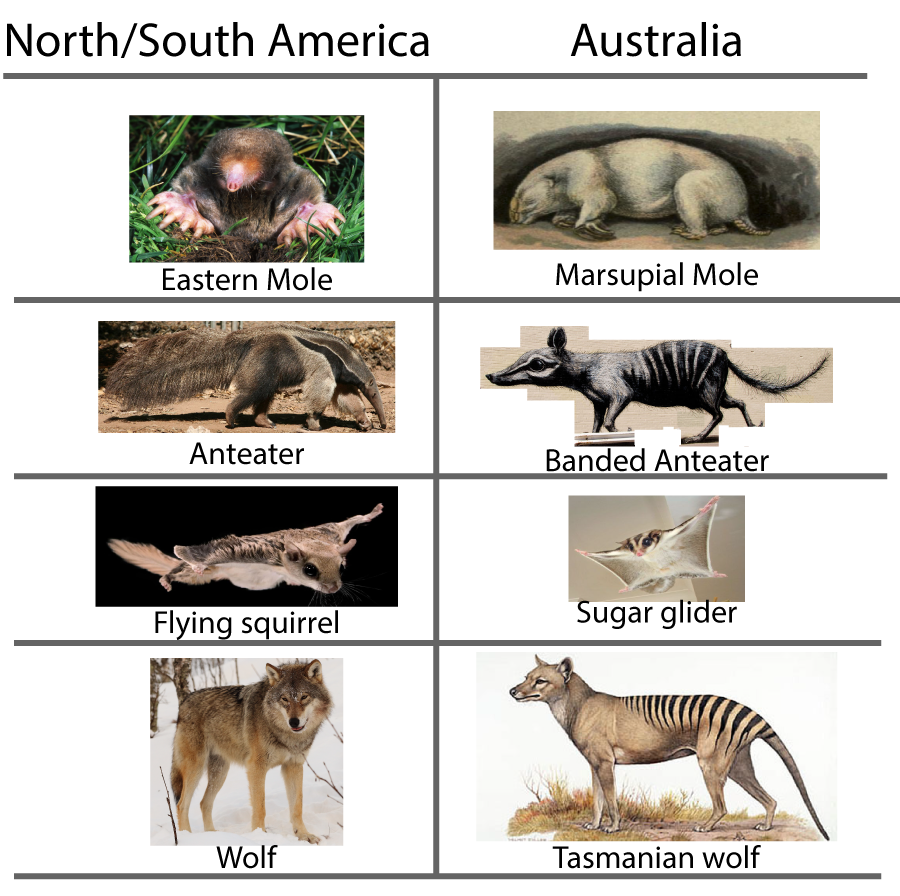
For another example of convergent evolution, let’s return to the question we stated in the introduction: Why do so many marsupials live only in and around Australia, and nowhere else?
As stated above, marsupial mammals have pouches where they carry their young. Placental mammals are like us: the fetus develops inside a uterus, supported by a placenta.
Study the pairs of animals in the diagram to the left.
Again, as with cacti and euphorbs, the similarity is superficial. The marsupial sugar glider and the flying squirrel have evolved similar adaptations, enabling both of them to glide long distances. But in terms of evolution, these two species are distantly related. Similar selective pressure upon their ancestors led each of these species to independently converge upon a gliding form. The same is true of the anteaters, gliders, and predators. In each case, natural selection led to convergence on a superficially similar form.
Why are the marsupials mostly in Australia? The answer has to do with species migrations and the movement of the continents over the past few hundred million years.
Take a moment to study the series of maps below. Pay attention to the times and the position of the continents. Here are the key reasons why the marsupials are so concentrated in Australia.
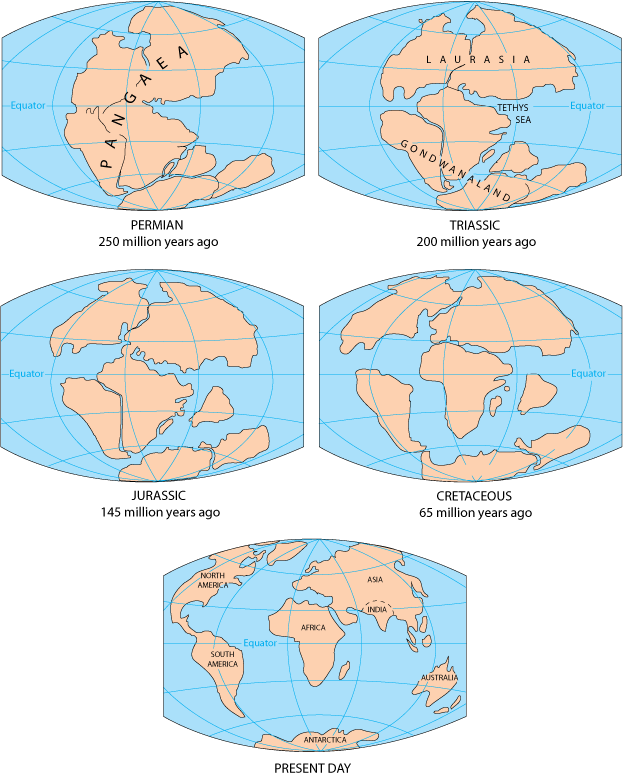
- The Marsupials first emerged in the Americas about 125 million years ago. At that time, land connected South America, Antarctica, and Australia. Antarctica, at that time, was not as cold as it is today. Marsupials spread from the Americas, through Antarctica, and arrived in Australia about 60 million years ago.
- Placental mammals emerged about 65 million years ago. Though it’s not clear why, it looks like placentals outcompeted the marsupials in many parts of the world, where many marsupials became extinct. That’s why, for example, almost all of the mammals of North America are placentals: the opossum is a notable exception.
- Before placentals could make it to Australia, that continent had separated from the rest of the continents. Except for bats, Australia remained mostly free of placental mammals.
The multiple instances of convergent evolution that has occurred between placental and marsupial mammals is sometimes referred to as parallel evolution. In each region, similar ecological niches were available. Into each of these niches, evolution unfolded in a parallel way.
- There was a niche for a burrowing mammal that could prey on worms and other organisms in the soil. Into that niche evolved the placental Eastern mole in the Americas, and the marsupial mole in Australia.
- Into the ant-eating niche evolved the placental South American anteater, and the Australian marsupial banded anteater, also called the numbat.
- Into the tree-living, small gliding niche evolved the placental flying squirrel in the Americas and the marsupial sugar glider in Australia.
- And into a top carnivore niche evolved the wolf in the Americas and the Tasmanian wolf (extinct since the 1930s) in Australia.
4. Flashcards: Convergent Evolution
[qdeck style=”width: 600px !important; min-height: 450px !important;” bold_text=”false” qrecord_id=”sciencemusicvideosMeister1961-Convergent Evolution Flashcards (v2.0)”]
[h] Convergent Evolution Flashcards
[q] Define biogeography.
[a] Biogeography is the study of the distribution of plants and animals.
[q] What’s a biogeographical question related to koala bears (or marsupials in general)?
[a] A biogeographical question might be “Why are marsupial mammals so common in and around Australia, but so rare in other places?”
[q] __________________ evolution is the process by which similar selective pressures act upon _____________ related lineages, resulting in _______________ similar _______________ in the descendants.
[a] Convergent evolution is the process by which similar selective pressures act upon distantly related lineages, resulting in superficially similar adaptations in the descendants.
[q] Compare adaptive radiation and convergent evolution.
[a] In adaptive radiation, one ancestral species diverges into several descendant species, each with distinct adaptations. In convergent evolution, unrelated lineages converge into superficially similar forms.
[q] Explain how euphorbs and cacti came to be so superficially similar, despite not being closely related.
[a] Over the course of evolution, the lineage that led to the cacti became adapted to the deserts of North and South America. Completely separately, another lineage became adapted to the deserts of Eurasia, Africa, and Australia, giving rise to the euphorbs. If you look superficially, cacti and euphorbs have similar adaptations (leaves reduced to spines; waxy, water-storing stems). But a deeper look (one that includes, for example, looking at their DNA), reveals that euphorbs and cacti aren’t closely related.
[/qdeck]
5. Convergent evolution leads to analogous structures
Look at the three organisms below.
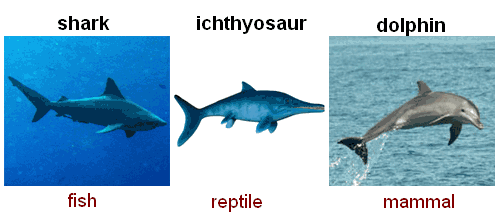
An ichthyosaur is an extinct marine reptile that perished at the same time as the dinosaurs became extinct, 65 million years ago. But from its fossils, we know that it had a streamlined shape, similar to that found in sharks and dolphins. The similar form shared by all three animals is not from common ancestry. It’s an example of convergent evolution. In each group of animals, similar selective pressures resulted in similar adaptations.
The similar forms that result from convergent evolution are said to be analogous. Analogous forms or structures are superficially similar forms that result from convergent evolution.
It’s important to keep the terms analogous and homologous (and the related nouns analogy and homology) distinct. Practice their definitions.
[qdeck bold_text=”false” qrecord_id=”sciencemusicvideosMeister1961-Analogy vs. Homology: Flashcards (v2.0)”]
[h]Analogy vs. Homology: Flashcards
[q]What are analogous forms or structures?
[a]Analogous forms or structures are superficially similar forms that result from convergent evolution.
[q]What are homologous structures?
[a]Homologous structures are structures that are inherited from a common ancestor and which have evolved different functions.
[/qdeck]
Now answer the questions in the quiz below.
[qwiz qrecord_id=”sciencemusicvideosMeister1961-Homology or Analogy? (v2.0)”]
[h] Homology or Analogy?
[q multiple_choice=”true”] The wing of a butterfly and the wing of a bat.
[c]IGhvbW9sb2d5[Qq]
[f]IE5vLiBUaGVzZSB3aW5ncyBhcmUgYm90aCBhZGFwdGF0aW9ucyBmb3IgZmx5aW5nLiBCdXQgdGhleSBkaWRuJiM4MjE3O3QgcmVzdWx0IGZyb20gaW5oZXJpdGFuY2UgZnJvbSBhIGNvbW1vbiBhbmNlc3Rvci4=[Qq]
[c]IEFuYW xvZ3k=[Qq]
[f]IEV4Y2VsbGVudC4gVGhlc2Ugd2luZ3MgYXJlIHRoZSByZXN1bHQgb2YgY29udmVyZ2VudCBldm9sdXRpb24sIG5vdCBjb21tb24gYW5jZXN0cnkuIFRoZXkmIzgyMTc7cmUgYW5hbG9nb3VzIChub3QgaG9tb2xvZ291cyku[Qq]
[q multiple_choice=”true”] The beak of a platypus (a mammal) and the beak of a duck (a bird).
[c]IGhvbW9sb2d5[Qq]
[f]IE5vLiBUaGVzZSBiZWFrcyBhcmUgYm90aCBhZGFwdGF0aW9ucyBmb3IgZWF0aW5nLiBCdXQgdGhleSBkaWRuJiM4MjE3O3QgcmVzdWx0IGZyb20gaW5oZXJpdGFuY2UgZnJvbSBhIGNvbW1vbiBhbmNlc3Rvci4=[Qq]
[c]IEFuYW xvZ3k=[Qq]
[f]IE5pY2Ugam9iLiBUaGVzZSBiZWFrcyBhcmUgdGhlIHJlc3VsdCBvZiBjb252ZXJnZW50IGV2b2x1dGlvbiwgbm90IGNvbW1vbiBhbmNlc3RyeS4gVGhleSYjODIxNztyZSBhbmFsb2dvdXMgKG5vdCBob21vbG9nb3VzKS4=[Qq]
[q multiple_choice=”true”] The forearm of a human being and the flipper of a dolphin.
[c]IGhvbW 9sb2d5[Qq]
[f]IEZhYnVsb3VzLiBUaGVzZSBmb3JlYXJtcyBhcmUgYm90aCB2YXJpYXRpb25zIG9uIGEgYmFzaWMgdmVydGVicmF0ZSBmb3JlYXJtIHRoZW1lLiBUaGUgc2ltaWxhcml0eSBpbiB0aGUgdW5kZXJseWluZyBib25lcyBzaG93cyBldmlkZW5jZSBvZiBjb21tb24gYW5jZXN0cnkuIEVhY2ggZm9yZWFybSBoYXMgYmVlbiBtb2RpZmllZCBhcyBhbiBhZGFwdGF0aW9uIGZvciBhIHNwZWNpZmljIGVudmlyb25tZW50LiBUaGF0IG1ha2VzIHRoZW0gaG9tb2xvZ291cy4=[Qq]
[c]IEFuYWxvZ3k=[Qq]
[f]IE5vLiBBbmFsb2dvdXMgc3RydWN0dXJlcyByZXN1bHQgZnJvbSBjb252ZXJnZW50IGV2b2x1dGlvbi4gVGhleSYjODIxNztyZSBhbmFsb2dvdXMgaW4gdGVybXMgb2YgdGhlaXIgZnVuY3Rpb24uIEluIHRoaXMgY2FzZSwgdGhlIGZ1bmN0aW9uIG9mIHRoZSBmb3JlbGltYiBpcyBxdWl0ZSBkaWZmZXJlbnQu[Qq]
[q multiple_choice=”true”] WARNING: Think carefully! The forelimb of a bird and the forelimb of a bat are composed of similar bones. These forelimbs are
[c]IGhvbW9s b2dvdXM=[Qq]
[f]IEZhYnVsb3VzLiBJZiB5b3UgYXJlIHRoaW5raW5nIG9mIHRoZXNlIGFzIA==Zm9yZWxpbWJzIA==KGFzIG9wcG9zZWQgdG8=IGFzIHdpbmdzKQ==IHRoZW4gdGhleSYjODIxNztyZSBib3RoIHZhcmlhdGlvbnMgb24gYSBiYXNpYyB2ZXJ0ZWJyYXRlIGZvcmVhcm0gdGhlbWUuIFRoZSBzaW1pbGFyaXR5IGluIHRoZSB1bmRlcmx5aW5nIGJvbmVzIHNob3dzIGV2aWRlbmNlIG9mIGNvbW1vbiBhbmNlc3RyeS4=[Qq]
[c]IGFuYWxvZ291cw==[Qq]
[f]IE5vLiBUaGlzIGlzIHZlcnkgdHJpY2t5LiBJZiB0aGUgcXVlc3Rpb24gd2FzIGFib3V0IFdJTkdTLCB5b3UmIzgyMTc7ZCBiZSByaWdodCwgYmVjYXVzZSB0aGUgdHdvIGdyb3VwcyAoYmlyZHMgYW5kIG1hbW1hbHMpIGNvbnZlcmdlZCBvbiB0aGUgc2FtZSBzb2x1dGlvbi4gQnV0IHRoZSBxdWVzdGlvbiBpcyBhYm91dCB0aGUgZm9yZWxpbWJzLiBBcyBmb3JlbGltYnMgZ28sIHRoZXNlIHN0cnVjdHVyZXMgYXJlIGhvbW9sb2dvdXM6IHNhbWUgYm9uZXM7IHNhbWUgZW1icnlvbmljIHRpc3N1ZTsgaW5oZXJpdGVkIGZyb20gYSBjb21tb24gYW5jZXN0b3Iu[Qq]
[q multiple_choice=”true”] WARNING: Think carefully! The wing of a bird and the wing of a bat are both adaptations for flying. Both birds and bats evolved (separately) from non-flying, ground-living ancestors. The wings are
[c]IGhvbW9sb2dvdXM=[Qq]
[f]IE5vLiBJZiB5b3UgYXJlIHRoaW5raW5nIG9mIHRoZXNlIGFzIFdJTkdTLCB0aGVzZSBhcmUgbm90IHNoYXJlZCBmZWF0dXJlcyB0aGF0IHdlcmUgaW5oZXJpdGVkIGZyb20gYSBjb21tb24gYW5jZXN0b3IuIFRoZSBhbmNlc3RvcnMgb2YgYmF0cyB3ZXJlIHJvZGVudC1saWtlIG1hbW1hbHMgd2hvIGV2b2x2ZWQgaW50byBhIGZseWluZyBuaWNoZS4gVGhlIGFuY2VzdG9ycyBvZiBiaXJkcyB3ZXJlIHNtYWxsIGRpbm9zYXVycyB3aG8gc2ltaWxhcmx5IGV2b2x2ZWQgaW50byBhIGZseWluZyBuaWNoZS4gQnV0IHRoZXkgZGlkIHRoaXMgaW5kZXBlbmRlbnRseS4gVGhlIHdpbmdzIGFyZSBhbmFsb2dvdXMsIG5vdCBob21vbG9nb3Vz[Qq]
[c]IEFuYWxv Z291cw==[Qq]
[f]IFdvdyEgVGhpcyBpcyB2ZXJ5IHRyaWNreSwgYnV0IHlvdSBzdGlsbCBnb3QgaXQgcmlnaHQhIFR3byBncm91cHMgKGJpcmRzIGFuZCBtYW1tYWxzKSBjb252ZXJnZWQgb24gdGhlIHNhbWUgc29sdXRpb24uIFRoYXQgbWFrZXMgdGhlbSBhbmFsb2dvdXMgc3RydWN0dXJlcywgcmVzdWx0aW5nIGZyb20gY29udmVyZ2VudCBldm9sdXRpb24u[Qq]
[q]This diagram is saying that the streamlined form of sharks, dolphins and ichthyosaurs is an [hangman] feature. That’s because this form evolved from [hangman] evolution, and not from a common [hangman].
[c]YW5hbG9nb3Vz[Qq]
[c]Y29udmVyZ2VudA==[Qq]
[c]YW5jZXN0b3I=[Qq]
[/qwiz]
6. Biogeography, Analogies, and Convergent Evolution: Checking Understanding
[qwiz qrecord_id=”sciencemusicvideosMeister1961-Biogeography, Analogies, and Convergent evolution (v2.0)”]
[h]Biogeography, Analogies, and Convergent evolution
[i]
[q]The study of the geographic distribution of species is called [hangman].
[c]YmlvZ2VvZ3JhcGh5[Qq]
[q]Species such as the euphorbs of Africa, Eurasia, and Australia and the cacti of the Americas are similar because of [hangman] evolution. Similar natural [hangman] resulted in the evolution of similar [hangman] in each group.
[c]Y29udmVyZ2VudA==[Qq]
[c]c2VsZWN0aW9u[Qq]
[c]YWRhcHRhdGlvbnM=[Qq]
[q]The marsupials of Australia and the placentals of the Americas separately evolved into similar ecological roles. While the marsupial mole of Australia and the Eastern mole of North America have similar [hangman] for a life spent burrowing through the soil, their similarity is only superficial, a result of [hangman] evolution
[c]YWRhcHRhdGlvbnM=[Qq]
[c]Y29udmVyZ2VudA==[Qq]
[q]The euphorbs of Africa, Eurasia, and Australia and the cacti of the Americas aren’t particularly closely [hangman]. Their superficially similar adaptations weren’t inherited from a common [hangman]. The best way to describe them is as [hangman] traits.
[c]cmVsYXRlZA==[Qq]
[c]YW5jZXN0b3I=[Qq]
[c]YW5hbG9nb3Vz[Qq]
[q] [hangman] traits result from shared ancestry. There is a similar underlying structure, but the [hangman] might be different.
[c]IGhvbW9sb2dvdXM=[Qq]
[c]ZnVuY3Rpb24=[Qq]
[q][hangman] traits result from convergent evolution. The function of the part might be similar, but the underlying [hangman] is usually quite different.
[c]QW5hbG9nb3Vz[Qq]
[c]c3RydWN0dXJl[Qq]
[q]REVIEW: Homologous structures, like the beaks of the Hawaiian honeycreepers shown below, evolve through [hangman] [hangman]. All of these Honeycreepers, in other words, share a common [hangman]. Over time, each species’ beak became [hangman] to a slightly different food source.
[c]YWRhcHRpdmU=[Qq]
[c]cmFkaWF0aW9u[Qq]
[c]YW5jZXN0b3I=[Qq]
[c]YWRhcHRlZA==[Qq]
[q]The beaks of the platypus and the duck are [hangman] structures that arose through [hangman] evolution.
[c]YW5hbG9nb3Vz[Qq]
[c]Y29udmVyZ2VudA==[Qq]
[/qwiz]
7. More Biogeography: Life on Oceanic Islands

Oceanic islands are small, usually volcanic islands that are located at a considerable distance away from the nearest continent. Think of islands like the Galapagos (1000 kilometers away from Ecuador), or the Hawaiian islands (2500 kilometers away from the west coast of North America).
Biologically, these islands have a few things in common.
- They are missing many types of animals and plants found on continents or on large continental islands. Examples of large continental islands are the British isles, Taiwan, New York’s Long Island, etc. These islands are both large and close to the nearest continent.
- On all oceanic islands, the same types of organisms are missing: amphibians, freshwater fish, land mammals, and, with a few exceptions, reptiles.

Hawaiian honeycreepers. Modified from an image by the Bioninja. - Oceanic islands are rich in native insects, birds, and plants. Many of these species are endemic: found only in that particular group of islands, and nowhere else.
- Often, these endemic species are members of groups of similar species. We’ve already discussed the finches on the Galapagos islands and Hawaii’s honeycreepers. Below is another example of Hawaii’s biodiversity: a group of 18 Hawaiian moth species, all in the genus Hyposmocoma. Like the birds above, they’ve evolved into a wide variety of ecological niches, including aquatic species and predatory species
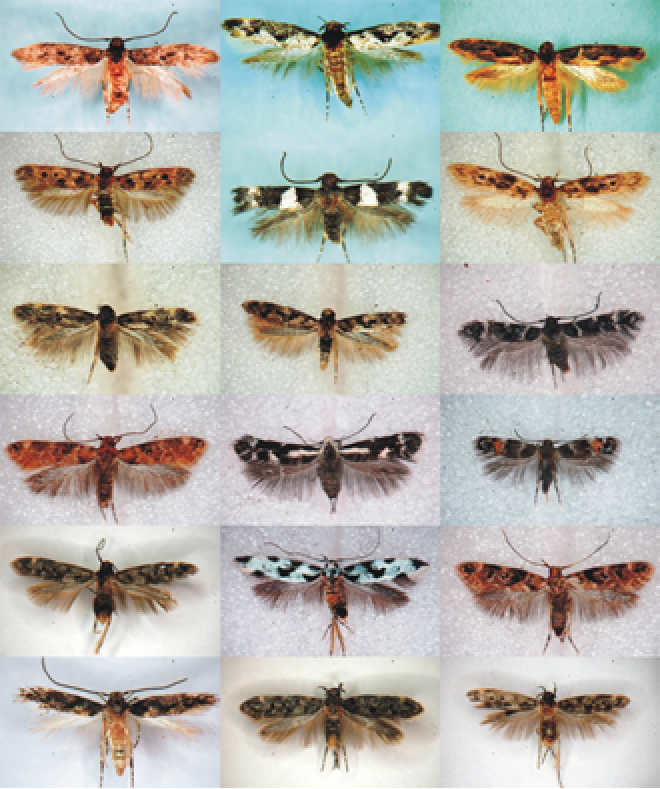
[qwiz style=”width: 600px !important; min-height: 450px !important;” qrecord_id=”sciencemusicvideosMeister1961-Explaining the biology of remote oceanic islands (v2.0)”]
[h]Explaining the biology of remote oceanic islands
[i]How do we explain the high diversity of endemic species on remote islands? How do we account for the lack of entire categories of animals?
[q labels = “top”]The reason why there are no terrestrial mammals, reptiles, amphibians, or freshwater fish on remote islands is that these types of animals have no way of ____________ these islands. The _________ surrounding these __________ makes ______________ by these kinds of animals impossible.
[l]colonization
[fx] No, that’s not correct. Please try again.
[f*] Correct!
[l]islands
[fx] No, that’s not correct. Please try again.
[f*] Correct!
[l]colonizing
[fx] No. Please try again.
[f*] Excellent!
[l]oceans
[fx] No. Please try again.
[f*] Excellent!
[q]Why do oceanic islands have so many _______, plants, and insects? Because while these volcanic islands might be geologically ________ compared to continents, they’re still __________ of years old. While colonization is __________, it does happen as small populations of birds, insects, or plant seeds get blown to these islands in _________, or simply fly off course.
[l]difficult
[fx] No, that’s not correct. Please try again.
[f*] Excellent!
[l]birds
[fx] No, that’s not correct. Please try again.
[f*] Good!
[l]millions
[fx] No. Please try again.
[f*] Excellent!
[l]storms
[fx] No, that’s not correct. Please try again.
[f*] Great!
[l]young
[fx] No, that’s not correct. Please try again.
[f*] Good!
[q]When they do arrive, they’re often the only examples of their kind on the island. This sets the stage for __________ ___________. Few ______________ species might serve as the original ___________. But over the subsequent years, each ancestor _______________ into many descendant species. That’s why remote oceanic islands are the home to so many ____________ species (species found only in that location).
[l]ancestral
[fx] No. Please try again.
[f*] Excellent!
[l]adaptive
[fx] No. Please try again.
[f*] Good!
[l]colonists
[fx] No, that’s not correct. Please try again.
[f*] Good!
[l]diversifies
[fx] No. Please try again.
[f*] Great!
[l]endemic
[fx] No. Please try again.
[f*] Good!
[l]radiation
[fx] No. Please try again.
[f*] Great!
[q]For the most part, land-living mammals can’t reach oceanic islands. But one type of mammal that can reach these islands. This is the the only flying mammal: the [hangman]. Also, not surprisingly, mammals that can [hangman], like seals, are also capable of colonizing oceanic islands.
[c]YmF0[Qq]
[c]c3dpbQ==[Qq]
[q]In terms of reptiles, most oceanic islands are completely free of native snakes and lizards. But the Galapagos islands have three species of iguanas. Their ancestors probably arrived through rafting on logs or mats of vegetation. Once on the Galapagos, one lineage into the marine iguana (shown below), the world’s only aquatic lizard.
[/qwiz]
7. Parallel Evolution and Convergent Evolution
Above, when discussing North American Placentals and Australian Marsupials, and in two previous tutorials, we’ve used the term “parallel evolution.”

In discussing the evolution of the spineless form in the threespine stickleback, we saw how the spineless form emerged in separate populations: essentially, anywhere that the sticklebacks were stranded in freshwater lakes and couldn’t return to the ocean.

In each case where the spineless form evolved, the mutation—deleted DNA adjacent to the PitX 1 Pelvic Enhancer — was different.
So we have are multiple populations separately evolving the same phenotype. As with Australian marsupials and North American placentals, you can say that all of these populations are converging on the same evolutionary solution… Or you can say that these populations are evolving in parallel.
In discussing the rock pocket mouse, we similarly saw that the dark-colored phenotype arose in geographically separated populations living on different lava flows. Furthermore, analysis of the mutation in the M1CR gene that produces the dark-colored phenotype showed that in different populations, different mutations were responsible for producing the phenotype. Again, the different populations were converging on the same evolutionary solution. Or you can say that in these various populations, the evolution was parallel.
The distinction between parallel evolution and convergent evolution is very subtle. As an AP Bio student learning about evolutionary biology, you can think of the two terms as more or less synonymous. But if you want to tease them apart, you can read this article on Britannica.com or this one on Wikipedia.
8. Biogeography and Convergent Evolution: Checking Understanding
[qwiz qrecord_id=”sciencemusicvideosMeister1961-Biogeography and Convergent evolution (v2.0)”]
[h]Biogeography and Convergent evolution
[i]Biohaiku
An island’s fauna
So many birds and insects!
But no land mammals
[q]The study of the geographic distribution of species is called [hangman].
[c]YmlvZ2VvZ3JhcGh5[Qq]
[q]Species such as the euphorbs of Africa, Eurasia, and Australia and the cacti of the Americas are similar because of [hangman] evolution. Similar [hangman] pressures resulted in the evolution of similar [hangman] in each group.
[c]Y29udmVyZ2VudA==[Qq]
[c]c2VsZWN0aXZl[Qq]
[c]YWRhcHRhdGlvbnM=[Qq]
[q]The marsupials of Australia and the placentals of the Americas separately evolved into similar ecological [hangman]. While the marsupial mole of Australia and the Eastern mole of North America have similar [hangman] for a life spent burrowing through the soil, their phenotypic similarity is only superficial, a result of [hangman] evolution
[c]bmljaGVz[Qq]
[c]YWRhcHRhdGlvbnM=[Qq]
[c]Y29udmVyZ2VudA==[Qq]
[q]The euphorbs of Africa, Eurasia, and Australia and the cacti of the Americas aren’t particularly closely [hangman]. Their superficially similar adaptations weren’t inherited from a common [hangman]. The best way to describe them is as [hangman] traits.
[c]cmVsYXRlZA==[Qq]
[c]YW5jZXN0b3I=[Qq]
[c]YW5hbG9nb3Vz[Qq]
[q] [hangman] traits result from shared ancestry. There is a similar underlying structure, but the [hangman] might be different.
[c]IGhvbW9sb2dvdXM=[Qq]
[c]ZnVuY3Rpb24=[Qq]
[q][hangman] traits result from convergent evolution. The function of the part might be similar, but the underlying [hangman] is usually quite different. On the level of the entire organism, we can say that organisms are in a similar ecological [hangman], and therefore require a similar suite of adaptations.
[c]QW5hbG9nb3Vz[Qq]
[c]c3RydWN0dXJl[Qq]
[c]bmljaGU=[Qq]
[q]Oceanic islands, like the Galapagos Islands or the Hawaiian islands, are rich in endemic species. “Endemic” means that these species are [hangman] to a particular area, but found nowhere else.
[c]bmF0aXZl[Qq]
[q]The diversity of island species such as the Hawaiian Honeycreepers can be explained through the concept of [hangman] [hangman]. All of these Honeycreepers, in other words share a common [hangman]. Over time, each species evolved to fill a different ecological [hangman].
[c]YWRhcHRpdmU=[Qq]
[c]cmFkaWF0aW9u[Qq]
[c]YW5jZXN0b3I=[Qq]
[c]bmljaGU=[Qq]
[q]One feature of island biology is that islands lack specific types of animals: amphibians, freshwater fish, land mammals, and reptiles. That’s because these types of animals are unable to cross the [hangman] that isolate these islands and thus are never able to [hangman] the islands.
[c]b2NlYW5z[Qq]
[c]Y29sb25pemU=[Qq]
[/qwiz]
9. What’s next?
Click the link to Topics 7.6 – 7.8, Part 5: Embryological, Molecular, and Genetic Evidence, the next tutorial in AP Bio Unit 7.
